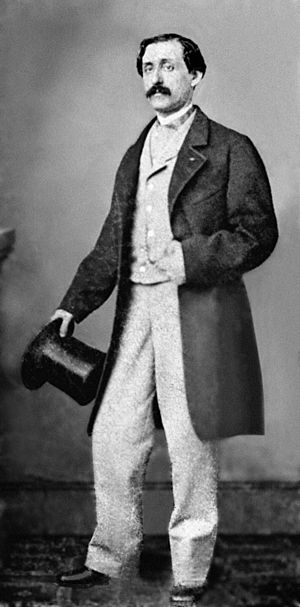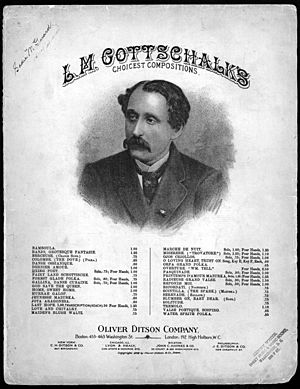Louis Moreau Gottschalk facts for kids
Quick facts for kids
Louis Moreau Gottschalk
|
|
|---|---|

Photograph by Mathew Brady
(late 1850s–early 1860s) |
|
| Born |
Louis Moreau Gottschalk
May 8, 1829 |
| Died | December 18, 1869 (aged 40) Rio de Janeiro, Brazil
|
| Occupation |
|
Louis Moreau Gottschalk (born May 8, 1829 – died December 18, 1869) was a super talented American composer and pianist. He was famous for playing his own romantic piano music really well. He spent most of his life performing and composing outside the United States.
Contents
Early Life and Musical Beginnings
Louis Moreau Gottschalk was born in New Orleans, Louisiana. His parents were Edward Gottschalk and Aimée Marie Bruslé. He grew up in a lively city with many different musical traditions.
Louis started playing the piano when he was very young. People quickly saw that he was a child prodigy, meaning he had amazing talent. He gave his first public performance in 1840 at the St. Charles Hotel.
Training in Europe
When Louis was just 13, he left the United States. He sailed to Europe to get a classical music education. He and his father knew this was important for his musical dreams.
He tried to join the Paris Conservatoire, a famous music school. But they turned him down because he was American! A teacher there even said, "America is a country of steam engines."
However, Louis found other ways to study music. He wrote early pieces like Bamboula (Danse Des Nègres) and La Savane. These songs showed his unique American style. They used sounds from Louisiana Creole music and even slave music. This made them very special and different from European music.
After one concert, the famous composer Frédéric Chopin told him, "Give me your hand, my child; I predict that you will become the king of pianists." Other great musicians like Franz Liszt also recognized his amazing talent.
Travels and New Music
Gottschalk returned to the United States in 1853. After that, he traveled a lot, especially to Central and South America. In 1854, he visited Cuba. This trip started many more journeys to other countries.
He also went to Puerto Rico and loved the music he heard there. He wrote a piece called Souvenir de Porto Rico; Marche des gibaros. "Gibaros" was an old way to say jíbaro, which means Puerto Rican farmers. The song's main tune might have come from a Puerto Rican folk song.
Mentoring a Young Talent
After his tours, Gottschalk rested in New Jersey and New York City. There, he met a very young student named Teresa Carreño from Venezuela. Gottschalk rarely took students. He was also careful about child prodigies. But Teresa was special, and he wanted her to succeed.
He could only give her a few lessons because he was so busy. Still, Teresa always remembered him fondly. She played his music throughout her life. A year after meeting Gottschalk, she performed for Abraham Lincoln. She later became a famous concert pianist, known as the "Valkyrie of the Piano."
Connecting with Artists
In the mid-1850s, Gottschalk met other important artists in New York. These included sculptor Erastus Dow Palmer and painter Frederic Edwin Church. Church had also traveled a lot in Latin America. He painted large pictures of South American scenes.
Gottschalk dedicated a piece called Mazurka poétique to Church. Church gave Gottschalk a small painting in return. Gottschalk might have also worked with George William Warren on a piano piece. This piece, The Andes, Marche di Bravoura, was inspired by Church's painting, The Heart of the Andes.
Later Career and Final Years
By the 1860s, Gottschalk was the most famous pianist in the New World. Even though he was from New Orleans, he supported the Union during the American Civil War. He only visited his hometown for concerts. But he always said he was from New Orleans. During this time, he composed the Grande Tarantelle, Op. 67.
In May 1865, a newspaper said he had traveled 95,000 miles by train. It also said he had given 1,000 concerts! Later that year, he had to leave the United States. He never returned.
Gottschalk chose to travel to South America. He kept giving many concerts there. During a concert in Rio de Janeiro, Brazil, on November 24, 1869, he collapsed. He had just finished playing his piece Morte! (meaning "Death"). He collapsed as he started his famous piece Tremolo. He never recovered.
Three weeks later, on December 18, 1869, Louis Moreau Gottschalk died at age 40. He was in his hotel in Tijuca, Rio de Janeiro. His death was likely caused by yellow fever.
In 1870, his body was brought back to the United States. He was buried at the Green-Wood Cemetery in Brooklyn, New York City. His grave had a beautiful marble monument with an "Angel of Music" statue. Vandals damaged the statue in 1959. In 2012, a new "Angel of Music" statue was put in its place.
Gottschalk's Musical Works
Gottschalk's music was very popular when he was alive. His first songs caused a stir in Europe. Early pieces like Bamboula, La Savane, Le Bananier, and Le Mancenillier were based on music he heard growing up in Louisiana. They are seen as the first classical pieces to use Creole music.
Some of his works, like the 13-minute opera Escenas campestres, are still valued today. Gottschalk also used the Bamboula tune in his Symphony No. 1: A Night in the Tropics.
Sadly, many of his compositions were lost or destroyed after he died.
Recordings of His Music
Many pianists have recorded Gottschalk's piano music. The first important recordings of his orchestral music were made by Maurice Abravanel and the Utah Symphony Orchestra. Later, Vox Records released a large collection of his music on CD. This included the first recordings of his symphonies with their original orchestrations.
In 1984, Nimbus Records released The Lady Fainted, a collection of his piano pieces. Gottschalk's music was also used in the movie Aux Petits Bonheurs. Starting in the 1990s, Philip Martin recorded most of Gottschalk's piano music that still exists.
See also
 In Spanish: Louis Moreau Gottschalk para niños
In Spanish: Louis Moreau Gottschalk para niños
- Great Galloping Gottschalk, a ballet set to Gottschalk's music
- Clara Gottschalk Peterson, Gottschalk's sister, who was also a pianist and composer



